

International Trade News - Media Monitoring Service by EIN News. Import quota. An import quota is a limit on the quantity of a good that can be produced abroad and sold domestically.[1] It is a type of protectionist trade restriction that sets a physical limit on the quantity of a good that can be imported into a country in a given period of time.
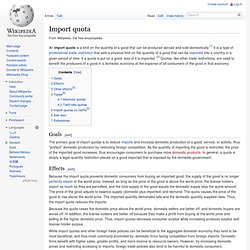
If a quota is put on a good, less of it is imported. [2] Quotas, like other trade restrictions, are used to benefit the producers of a good in a domestic economy at the expense of all consumers of the good in that economy. Goals[edit] The primary goal of import quotas is to reduce imports and increase domestic production of a good, service, or activity, thus "protect" domestic production by restricting foreign competition. As the quantity of importing the good is restricted, the price of the imported good increases, thus encourages consumers to purchase more domestic products.
In general, a quota is simply a legal quantity restriction placed on a good imported that is imposed by the domestic government. Effects[edit] International Trade in Agricultural Products: A Research Guide. For more information see: United Nations Documentation: Research Guide, accessible at: Jeanne Rehberg, United Nations: Lawmaking Activities and Documentation, in ACCIDENTAL TOURIST ON THE NEW FRONTIER: AN INTRODUCTORY GUIDE TO GLOBAL LEGAL RESEARCH 157-165 (Jeanne Rehberg and Radu D.
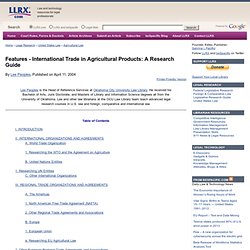
Popa, eds., Littleton, CO: Rothman, 1998) 2. Tools for UN Research UNBIS Thesaurus is an online thesaurus containing terminology used in United Nations documents, accessible at: UNBISnet is a catalog that searches bibliographic records of UN documents, voting records, and indexes to speeches, accessible at: UN-I-QUE is a ready-reference file created by the Dag Hammarskjöld Library to respond to frequently asked questions and to provide quick access to document symbols for UN materials, accessible at: The UN Document Centre provides access to a variety of basic UN documents, accessible at: FAO Trade in Agriculture Glossary and Acronyms, accessible at: 3. C. A. 1. A. HOLBEIN, JAMES R., AND DONALD J. Thomas Palley » Blog Archive » Jack Welch’s Barge: The New Economics of Trade. The classical theory of comparative advantage has driven US trade policy for the past fifty years.
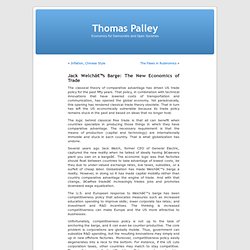
That policy, in combination with technical innovations that have lowered costs of transportation and communication, has opened the global economy. Yet paradoxically, this opening has rendered classical trade theory obsolete. That in turn has left the US economically vulnerable because its trade policy remains stuck in the past and based on ideas that no longer hold. International Economics. International Trade Forum - The quarterly magazine of the International Trade Centre. Heckscher-Ohlin Theorem. The original HO Theorem, however, was expressed in terms of relative abundance.
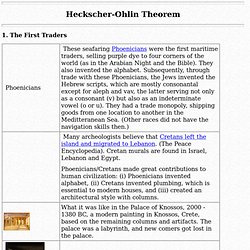
An economy's offer curve depends on both production and consumption conditions in that country. In the Ricardian trade model, it is easy to derive offer curves because each country specializes in the production of one commodity. This means that as the price of good changes production remains unchanged. Heckscher–Ohlin model. The Heckscher–Ohlin model (H–O model) is a general equilibrium mathematical model of international trade, developed by Eli Heckscher and Bertil Ohlin at the Stockholm School of Economics.
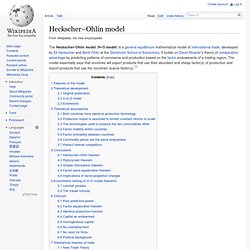
It builds on David Ricardo's theory of comparative advantage by predicting patterns of commerce and production based on the factor endowments of a trading region. The model essentially says that countries will export products that use their abundant and cheap factor(s) of production and import products that use the countries' scarce factor(s).[1] Features of the model[edit] For example, a country where capital and land are abundant but labor is scarce will have comparative advantage in goods that require lots of capital and land, but little labor—grains. If capital and land are abundant, their prices will be low. Theoretical development[edit] The Ricardian model of comparative advantage has trade ultimately motivated by differences in labour productivity using different "technologies". 2×2×2 model[edit] Home / Rybczynski Theorem 50th Anniversary - November 2005.